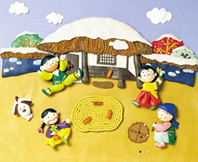
“Yut come out! Mo come out!” Many people who sit in a circle are shouting this while throwing four sticks. This game they are enjoying is yut. Yut is usually played on New Year’s Day and the 15th of January by the lunar calendar.
Yut has been played since the period of the Three Kingdoms. At first, this was used as a tool which told whether the year would be a fruitful year or a bad year. Afterwards, this gradually developed into amusement. To play yut, we need 4 sticks, a game board, markers, and a mat. Yut is made by splitting a small log into two. One side is flat and the other side is round. The game board is a square or a circle. The markers on the game board are mostly baduk pieces or buttons.
Yut can be played by individuals and teams. In the team match, usually two to four persons are on one team, and the people make two to three teams. Four markers are given to each team regardless of the number of people, and the team who carries all these markers to the end point the fastest is the winner. Each member throws the yuts in turn.
When you throw yuts, if only one of the yuts comes out on the flat side, this is “do,” and you can move a marker one step forward. “Gae” is when two yuts come out on the flat side, and you can move the marker two steps forward. “Guel” is when three yuts come out on the flat side, and you can move the marker three steps forward. “Yut” is when four yuts come out on the flat side, and you can move the marker four steps forward. If “yut,” comes out, you can throw once more. “Mo” is when four yuts come out on the round side, and you can move the marker five steps forward. If “mo” comes out, you also can throw one more yut. “Dwit do” is when one yut which is marked separately comes out on the flat side, and you should move the marker one step back. “Do,” “gae,” “guel,” “yut,” and “mo” mean domestic animals. “Do” means a pig, “gae” means a dog, “guel” means a sheep, “yut” means a cow, and “mo” means a horse.

The fastest way is home→A→C→home. In this case, first of all a marker must arrive at A. Then at your team’s next turn, you can go the fast course which is A to C not A to B. If you cannot pass through A, you have to go to the long way. You also have to take care not to be caught by your opponent’s marker. If your opponent’s marker arrives at a position on which your team’s marker is, you die and start again from the beginning. On the other hand, if your team’s marker reaches the position of another of your markers, you can move both at a time from the next turn. If you throw the yuts and the yuts go off the mat, you can’t move your markers, and it means losing one turn.
If you have an opportunity, try playing yut. You can understand a folk game of Korea as well as feel amusement.
By Kim Su-jin
KMG Junior Reporter
fortunate333@kmu.ac.kr
KMG Junior Reporter
fortunate333@kmu.ac.kr








